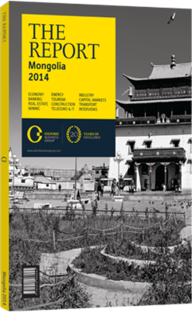Ready for take-off: A new airport near the capital is due to open in 2016
Mongolia’s international gateway is well run but in need of an upgrade. It was designed for a different time and for a different type of travel and will soon be overtaken by events, as Mongolia’s economy expands, as traffic increases and as the country’s international profile evolves. With that in mind, a new airport is being built, one that will be able to grow with the market and provide a high level of service. Most of all, it will be safer than the current airport and allow for more landings in a wider range of weather conditions.
Winds Of Change
Chinggis Khan International Airport is largely a relic of the Communist era. The airport was established in 1957 by the Ministry of Military and Social Security and was originally known as Buyant Ukhaa. The first flight, to Irkutsk, originated from the facility in 1958. The current terminal was opened in 1986, and the airport was refurbished with help of the Asian Development Bank in 1995. It was renamed Chinggis Khan in 2005. The airport has two runways, one asphalt and one grass, and because it is surrounded by mountains, aeroplanes can only take off in one direction; sometimes crosswinds can make landing impossible. This is the major drawback of the current facility and limits service to Mongolia’s capital. During the winter, wind conditions mean that safe landings are only possible 73% of the time (86% on average for the year). The current airport is conveniently located, 18 km south of the city, and can handle 600,000 people a year, but it is in the wrong place and not suitable for a fast-growing and prosperous Mongolia.
The new airport has been years in the works and a bit slow in getting started. As part of a 2008 agreement, the Japan Bank for International Cooperation offered ¥28.8bn ($300m) of funding toward an airport project expected to cost ¥34.2bn ($356m). The loan was for 40 years and had an interest rate of 0.2% (with no interest in the first 10 years). Ground was broken in April 2012, but construction started in 2013, mainly because of political uncertainties surrounding the parliamentary elections. The funding had to be renegotiated. Due to exchange rate movements, the total was increased in March 2013 by ¥17.1bn ($178m). The airport is now forecast to cost ¥50bn ($520m).
Increases In Passenger Capacity
The facility will be located 60 km south of the city in the Khushigt Valley, Tuv Province and will be finished by 2016. With six runways and the capacity to handle 3m passengers a year, and a design that can be expanded to handle 12m passengers on 20 runways, it will be a big improvement over Chinggis Khan. The airport will have two runways and should be much safer in severe weather conditions and at night. The wind coverage (the percentage of landings which are deemed safe given the wind conditions) is forecast to reach 95%. A city for 100,000 people will also be constructed nearby. The airport is being built by Mitsubishi Corporation and Chiyoda Corporation. The loan requires that Japanese contractors are used in the construction, but Samsung C&T Corporation will be involved in the building of the runway and local companies are also participating. A new road will be built for the airport and financed by the Ulaanbaatar City Fund.
If all goes as planned, Mongolia will have a new gateway in a few years and the capacity to handle a major influx of travellers. The next step will to improve the country’s connections with the rest of the world. While Mongolia is often described as isolated, it is actually conveniently located in terms of flying time (it is less than four hours from Seoul, Tokyo, Beijing and Shanghai).
Connections to the country have never been good, and travel to Mongolia can be quite expensive. In part, the prices are a function of the lack of traffic. However, on some routes, competition might have been artificially limited. For example, Korea’s Fair Trade Commission accused MIAT and Korean Air in 2012 of preventing Asiana Airlines from flying the Seoul-Ulaanbaatar route.
With a modern facility in place, Mongolia will need to ensure it is in line with international best practices and its air travel market remains competitive. It has the potential to increase traffic and attract more carriers.
You have reached the limit of premium articles you can view for free.
Choose from the options below to purchase print or digital editions of our Reports. You can also purchase a website subscription giving you unlimited access to all of our Reports online for 12 months.
If you have already purchased this Report or have a website subscription, please login to continue.

